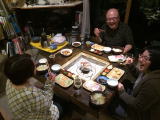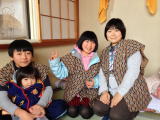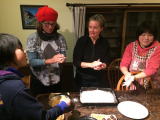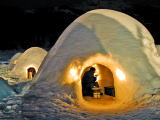In winter, you can enjoy and experience various kind of cross cultural at the hostel.
*Several program listed below are available all trough the year or, from autumn to spring
IRORI
IRORI(囲炉裏) is a traditional Japanese sunken hearth. Used for heating the home and for cooking food, it is essentially a square,
stone-lined pit on the table, equipped with an adjustable pothook and generally consisting of an rope made by straw used for raising
or lowering a suspended pot or kettle by means of an attached lever which is often decoratively designed in the shape of a Carp.
In our lounge, this irori is equipped and sometimes we enjoy chatting or table game while cooking and eating various kind of snacks.

ORIGAMI
ORIGAMI(折り紙) is the art of paper folding, which is often associated with Japanese culture.
From just one piece of square paper, you can make various kind of object.
Among them, the best-known origami model is the Japanese paper crane which is easy to make for even beginner.
The works you made can be the key holder as souvenir. (300 yen/piece)

RENTAL HANTEN
HANTEN(半纏), a short winter coat, is an item of traditional Japanese. The coat started to be worn, especially by the common
people, in the 18th century during the Edo period.
The shape of the hanten bears a resemblance to the haori and is worn by both males and females. The facing and lining are padded
with thick layer of wadded cotton for warmth. The collar is usually made of black sateen.
You can use this HANTEN as a room wear during your stay(no charge). So if you need, please tell us about it without any
hesitation(^_^)

MOCHI POUNDING
In Japanese homes in new year, we have a custom to have MOCHI(餅), chewy rice cakes made from glutinous rice.
Sometimes we peform pundning and making mochi by popular mochi-making machines in the lounge.
Why don't you join us and make sweet rice cakes for yourself!

*Reason Japanese eat mochi in January
Since long time ago, we Japanese have believed God come to each house on new year eve.
In order to receive god to their own house, people made mochi by the end of the year, and display on household shinto altar.
After God get back, people eat displayed mochi together and prayed their happiness.
So, eating mochi in January means praying happiness in the year.
KAMAKURA
